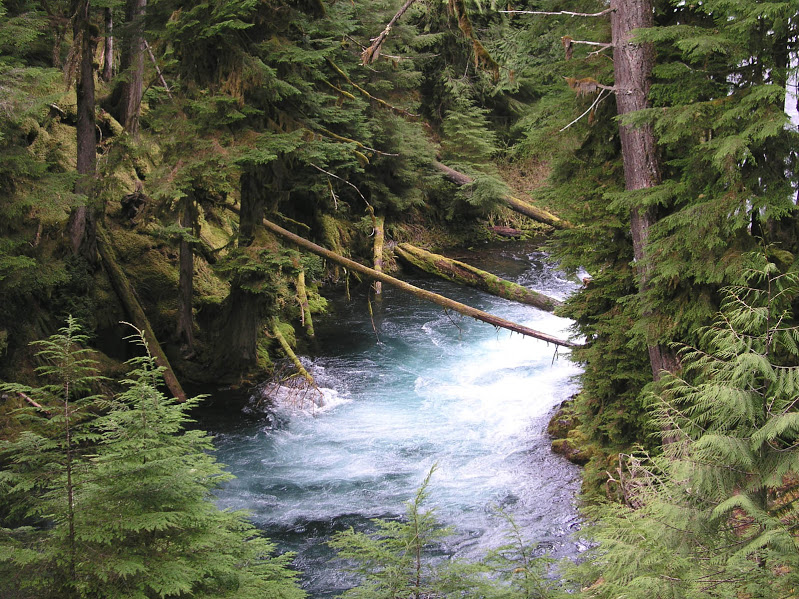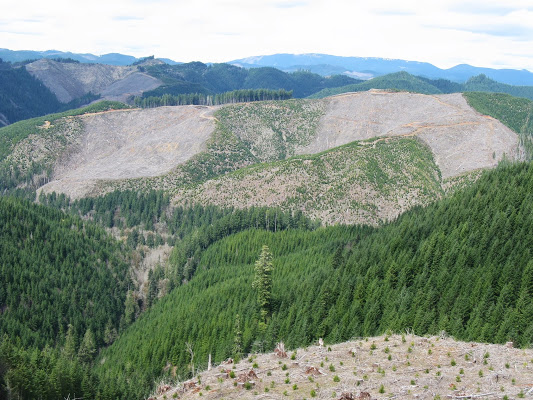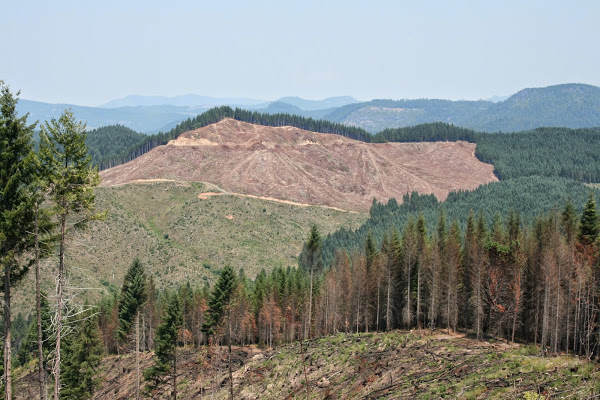Oregon: Home of the Clearcut
Ah, Oregon. When you think of Oregon, do you imagine scenic mountains, fresh air, serene forest lands, crisp clean water, and the beauty of undisturbed nature? Sadly, due to inadequate protection from the Oregon Forest Practices Act, portions of the state no longer reflect this pristine image.
“Welcome to Oregon, Home of the Clearcut” is the tongue-in-cheek campaign run by Oregon Wild, an organization devoted to protecting and restoring Oregon’s wildlands, wildlife, and waters as an enduring legacy for future generations. This non-profit works with the Forest Service, the public, local governments and other stakeholders in their efforts to protect the natural treasures that make Oregon such an amazing place to live. Conscious Connection recently had the opportunity to speak with Erik Fernandez, the Wilderness Coordinator at Oregon Wild, to learn more about the problems caused by clearcutting in Oregon.
The Basics: Climate Change
Our conversation with Fernandez began with the basics, reminding us that trees are essential in helping to protect our climate. Trees absorb carbon dioxide, removing and storing the carbon while releasing the oxygen back into the air. One of the best things we can do as citizens of the world is to protect our forests so that carbon stays stored in that wood. Unfortunately, when trees are logged, not only do we lose the cleaning power of those trees, but carbon is released into the atmosphere.
When the logging industry converts trees into 2×4’s, large portions of the trees that are logged go unused. Branches, knotty/unusable wood, and the portions of the tree that cannot be squared off into 2×4’s quickly release their stored carbon. Moreover, other uses include short term products such as pallets for shipping; these pallets are typically discarded after one use. On top of that waste, all of the pollution caused by transporting that lumber to the mill and then to its final destination for construction or retail sale is environmentally harmful as well.
Fernandez lamented, “We have a green reputation in Oregon, but it’s a reputation we’re not living up to. We know better, and we should be doing better.”
Clearcutting our National Forests
Surprisingly, a significant amount of clearcutting has taken place on public land in Oregon. While people may think that all federal land is protected, that is not the case. National parks are fairly well protected, but national forests are not, and many of Oregon’s forests have seen aggressive logging in the past.
If you take a look at the Mount Hood National Forest, for example, over 2,600 clearcuts have taken place on that landscape. It should be noted that the Forest Service has made channels available through which the public can voice their comments before cutting is allowed, and is now allowing more thinning and less clearcutting. Whenever cutting is being considered, the Forest Service will draft a plan stating where thinning or clearcutting is to be conducted, and then they will accept public commentary before taking action. The plans are posted on the Mt. Hood National Forest website, and they also have a mailing list available for interested parties. After the public has had time to respond to the plan, the Forest Service will decide upon its final plan and then auction the right to complete the logging to timber companies. Historically, the Forest Service would often times completely ignore public comment, but in recent years there has been improvement. While public comment is still sometimes ignored, the Forest Service has shown increasing willingness to incorporate the public’s concerns.
Privately Held Land: Third-World Logging Practices
While there is clearly room for improvement in logging practices on National Forests, Fernandez says that logging practices on private land are so archaic they can be described as “third world logging practices.” Besides the fact that clearcutting is impacting climate change, private-land clearcutting causes two further problems: watershed damage and herbicide contamination.
Watershed Damage: Communities across the state of Oregon depend on forest watersheds for pure drinking water. Logging near watersheds damages the forest’s ability to produce clean water in two ways. First, logging reduces the volume of water available due to increased runoff, greater evaporation due to loss of canopy, and reduced ability to gather water from fog. Secondly, water in clearcut areas flows more quickly, carrying with it additional soil and debris that foul water filtration systems further downstream.
While the headwaters of some watersheds and/or the intake facilities where a community gathers its water may be publicly owned and protected, the ownership of land in between those two areas is often private. As a result, there are many examples across Oregon in which drinking water has been impacted by aggressive clearcutting.

For instance, the McKenzie River provides drinking water for the cities of Eugene and Springfield, which have a combined population of over 220,000 residents. Though the headwaters of this river are in protected public lands and contain pristine, cold, clean water, privately owned industrial forests downstream have been butchered by timber companies. This is also the case for the Clackamas River, which provides drinking water to another 200,000 Oregonians, including those in Lake Oswego, Oregon City, West Linn, and Estacada.
Earlier this year, Bedell Guitars reported concerns related to clearcutting near Rockaway Beach. In this community, two companies own 1,400 acres of private forest land spread across a steep slope. From 2006 to 2012, more than 80% of these watershed forests were clearcut. This denudation forced the town to invested 1.5 million taxpayer dollars to upgrade filtration systems at the water treatment facility.
In yet another example, the Santiam River provides drinking water to the city of Salem, the second largest city in Oregon. Much of the public and private land surrounding the Santiam has been clearcut. Because of the clearcutting and the logging roads that had been built, rain storms in the late 90’s resulted in massive erosion that forced Salem to shut down their water plant and build an entirely new water treatment plant at tax payer expense.
Aerial Chemical Spraying: Yet another problem related to clearcutting is the hazardous chemicals that are sprayed following a clearcut. After a region has been clearcut, timber companies spray the area to suppress all vegetation except for replanted trees. These chemicals are often sprayed near homes, causing harm to animals and humans. This practice has been banned on public lands but is standard operating procedure on private forests.
One of the chemicals most commonly sprayed by timber companies for weed control is glyphosate. According to a May, 2015 article published in Collective Evolution, the number of countries choosing to ban glyphosate is growing at an exponential rate due to the fact that glyphosate has been directly linked to birth defects, nervous system damage, Alzheimers, Parkinson’s, various forms of cancer, and kidney failure.
Another chemical commonly used is known as “2, 4-D.” According to a 2012 article published in The Atlantic, decades of scientific studies link 2, 4-D to non-Hodgkin’s lymphoma, and newer studies link it to increased risk of birth defects and neurologic damage in children. Studies in Midwest wheat-growing areas where 2,4-D is heavily used have shown increased rates of certain birth defects, especially in male children, and lower sperm counts in adults.
A third chemical that is commonly used is atrazine. According to the Pesticide Action Network, atrazine interferes with hormonal activity of animals and humans at extremely low doses, and exposure has been linked to elevated risk of breast and prostate cancer.

Oregon’s forestry regulations do not require private companies to provide advance notice of their intentions to spray. Consequently, the only warning residents in nearby areas get is the sound of the helicopter buzzing as it approaches. At best, these residents can hurry their kids and pets inside so they don’t get sprayed by drift. Regardless, even if they are not directly affected by the spray, their water supply can become polluted by these chemicals.
According to Fernandez, violations are frequently reported regarding spray drift, and companies have been found to be spraying in unauthorized areas. Pets are getting sick and dying. When people get sick from the chemical spray, their doctors want to know what they have been sprayed with in order to determine the appropriate treatment. Unfortunately, citizens must file requests to identify the sprayed chemicals and may have to wait two to six weeks for a response, suffering in the interim.
What’s more, there has been laxity regarding fines levied for improper spraying. After Pacific Air Research repeatedly flew a helicopter over homes while spraying herbicides in 2013, 20 complaints of illness were filed. Initially, the Oregon Department of Agriculture proposed $20,000 in fines after its investigation found the company guilty of gross negligence and willful misconduct for spraying off-target and also for falsifying information about the chemicals used. However, on July 1, 2015, The Oregon Department of Agriculture dropped these fines. The Agriculture department did not respond to requests for comment or explain why the agency dropped the fines.
On the plus side, on the same day the Oregon House of Representatives voted to approve industry-backed legislation increasing maximum fines for pilots who spray off target. But as one of the sickened people pointed out, “What’s the point of making stronger penalties if they’re not going to uphold them?”
According to Fernandez, the only logical explanation for this behavior is that the Oregon Department of Forestry is run by the timber industry.
Revamping the Oregon Forest Practices Act
Oregon Wild and it’s partners have been fighting and will continue to fight for changes in the Oregon Forest Practices Act in order to protect the state’s environment and its residents. In the short run, Oregon Wild is hoping to effect three common sense changes. First, the organization would like to eliminate clearcut logging on steep slopes prone to landslides; if logged, these areas should only be thinned, not clearcut. Second, advance warnings should be required prior to herbicide spraying near homes. Third, bigger buffer zones should be required so that herbicides cannot be sprayed around homes, schools, or rivers.
Of course, these are only basic first steps toward real change. Oregon Wild’s long-term goals to modernize the Oregon Forest Practices Act also include requirements to manage at least some portion of state lands for mature/old-growth as well as tighter restrictions on chemical applications.
According to Fernandez, “It’s going to take time to achieve fundamental change. We are up against the timber industry, an industry that contributes a lot of money to a lot of politicians that have their backs. We have to educate the public, share the stories of people like those in Rockaway Beach whose drinking water supply is being degraded by the timber industry, and rally the public to demand change.”
“Reform will have to pass through the state legislature, and that will not be easy; we will need a lot of public education and pressure to get that done. Unfortunately, while we made a push in the current session of the legislature, it doesn’t look like any bills are going to pass that resolve any of these issues. So we will come back to the legislature next year, and in the interim we will work with the governor’s office, encouraing them to exert their influence to protect drinking water from logging impacts. It’s going to be a multi-year effort that will take place on a variety of fronts.”
Taking Action: What You Can Do
When we asked Fernandez about how people can help become agents for change, he answered: “To make a difference in the world these days, you don’t have to go off the grid and become a vegan and turn your lifestyle upside-down. You can make a difference simply by standing up and being counted.”
Fernandez continued, “You would be amazed at the change that would happen if people were to simply call their congressperson and demand a change they want to see. There’s only a small fraction of the public that actually does that. You don’t have to be an expert. If all the people who cared simply made a two-minute phone call and just said, ‘You need to do a better job at protecting the environment,’ it would have a huge impact.”
Along these lines, Conscious Connection is asking our readers to sign a petition to Oregon legislators to revamp the Oregon Forest Practices Act and help protect humans, wildlife and waterways. We would also like to encourage you to share the petition with your friends. In doing so, you, your friends, and the citizens of Oregon will be helping to make the world a greener place.





